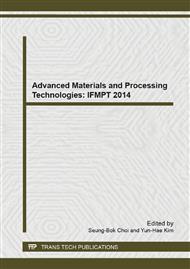[1]
Buch,N., and Zollinger D.G., Development of dowel looseness prediction model for jointed concrete pavements, Transportation research record. 1525, Transportation research board, Washington, D. C, p. pp.21-27 (1996).
DOI: 10.3141/1525-03
Google Scholar
[2]
Guo,H., Sherwood,J. A, and Snyder M.B. Component dowel-bar model for load-transfer systems in pcc pavement, Journal of Transportation Engineering, ASCE, Vol. 121(3), pp.289-298 (1995).
DOI: 10.1061/(asce)0733-947x(1995)121:3(289)
Google Scholar
[3]
Ioannides, A.M. and Korovesis,G. T Analysis and design of doweled slab-on-grade pavement systems, Journal of Transportation Engineering, ASCE, Vol. 118, pp.745-768 (1992).
DOI: 10.1061/(asce)0733-947x(1992)118:6(745)
Google Scholar
[4]
B.F. Friberg, Load and Deflection Characteristics of Dowels in Transverse Joints of Concrete Pavements, Proceedings of Highways Research Board No. 18. p.140–154, National Research Council. Washington, DC, United States of America (1938).
Google Scholar
[5]
Davids W.G. Effect of dowel looseness on response of jointed concrete pavement, Journal of Transportation Engineering Vol. 126, pp.50-57 (2000).
DOI: 10.1061/(asce)0733-947x(2000)126:1(50)
Google Scholar
[6]
E.J. Yoder, and M.W. Witczak, Principles of Pavement Design, 2nd Edition, John Wiley and Sons, Inc., New York, (1975).
Google Scholar
[7]
B. Huang, E. Tutumluer, I.L. Al-qadi, J. Prozzi and X. Shu, Paving Materials and Pavement Analysis, Proceedings of sessions of GeoShanghai 2010 International Conference, Shanghai, China, June 3-5 2010, American Society of Civil Engineers Publications (2010).
DOI: 10.1061/9780784411049.bm
Google Scholar
[8]
Brill, D.R., Calibration of FAARFIELD Rigid Pavement Design Procedure,. DOT/FAA/AR-09/57. Office of Research and Technology Development, Washington, DC 20591 (2010).
Google Scholar
[9]
Byrum, C.R., Barton, P.J., D. Rollings, R.S., Ioannides, A.M., Gemayel, C.A., Tayabji, S. Joint Load Transfer in Concrete Airfield Pavements: Final Report,. Innovative Pavement Research Foundation Report IPRF-01-G-002-05-2. Rosemont, IL. August, (2011).
Google Scholar
[10]
Ioannides, A.M. and M.I. Hammons. Westergaard-Type Solution for Edge Load Transfer Problem, Transportation Research Record 1525, Transportation Research Board, Washington, DC (1996).
DOI: 10.3141/1525-04
Google Scholar
[11]
Skarlatos, M. S and Ioannides A. M The Theory of Concrete Pavement Joints, Proceedings, Fourth International Workshop on design theories and their verification of concrete slabs for pavements and railroads, 10-11 september, Bussaco, Portugal, pp.187-208 (1998).
Google Scholar
[12]
A.I. Al-Hadidy and Y.Q. Tan, Mechanistic analysis of ST and SBS-modified flexible pavements, Construction and Building Materials, Vol. 23, No. 8, pp.2941-2950. (2009).
DOI: 10.1016/j.conbuildmat.2009.02.023
Google Scholar
[13]
S.H. Ju, Finite element investigation of traffic induced vibrations, Journal of Sound and Vibration, Vol. 321, No. 3-5, pp.837-853, (2009).
DOI: 10.1016/j.jsv.2008.10.031
Google Scholar
[14]
Austroads, Guide to pavement technology — Part 5: Pavement evaluation and treatment design, AGPT05/08, Sydney, NSW, Australia (2008).
Google Scholar
[15]
J. Kim, and K.D. Hjelmstad., Three-Dimensional Finite Element Analysis of Doweled Joints for Airport Pavements, Annual Meeting of Transportation Research Board Washington, D. C, (2003).
DOI: 10.3141/1853-12
Google Scholar
[16]
Skarlatos, M.S. Deflection and Stresses in Concrete Pavements of Airfields with Continuous Elastic Joints, Report AD 628501, US Army Engineer Ohio River Division Laboratories (1949).
Google Scholar
[17]
Teller, L.W., Sutherland E. C The Structural Design of Concrete Pavements Part 4- A Study of the Structural Action of Several Types of Transverse and Longitudinal Joints Designs, Public Roads Journal of Highway Research, USDA Vol 17., No. 7 and No. 8 (1936c).
Google Scholar
[18]
Teller, L.W., Cashell, H. D Performance of Dowelled Joints under Repetitive Loading, Public Roads, Volume 30 No. 1. US Department of Commerce. Advisory Circular AC 150/5320-6E (2010).
Google Scholar


